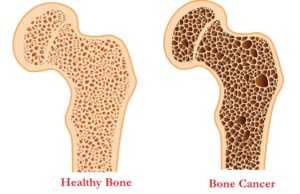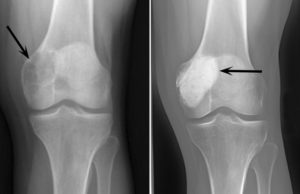Cancer or tumor can occur anywhere in the body and bone cancer is a rare phenomenon. Cancer originating in the bones is called as bone cancer and it can occur in any bone. Long bones in the body belonging to that of thighs and arms are largely affected with bone cancer. As said earlier, bone cancer is a rare type of cancer targeting elderly patients. People who are undergoing chemo and radiation therapy for other forms of cancer are vulnerable to bone cancer.
Signs and Symptoms :
Swelling of muscles and tissues in the affected bone area and bone pain are primary symptoms of bone cancer. The affected bone becomes tender and is prone to break even with mild injury. Other common symptoms of bone cancer include loss of weight, fatigue and easily breaking bones.
Causes Of Bone Cancer :
It is not known why some people get bone cancer and others not. Bone cancer is believed to develop due to genetic mutation like many other types of cancer. Cells begin to grow and multiply in repeated fashion without any obvious reason and accumulate in a place to form a tumor. This mass or tumor would gradually invade and destroy nearby tissues and organs spreading to other parts of the body.
- Abnormal Cell Growth – Under normal condition, healthy cells are formed which remove and destroy older cells. After some period, these cells become old and get replaced with fresh set of healthy cells. However, in some cases, older cells do not perish and gets accumulated with fresh healthy cells. Thus several cells are piled up to form a mass or tumor which then becomes malignant (cancer causing).
- Radiation Treatment – Cancer patients are given radiation therapy and chemotherapy in combined manner. But in some people, this radiation treatment forms the cause for build-up of more number of cells in particular part of the body leading to cancer.
Different Kinds Of Bone Cancer :
1. Multiple Myeloma – Multiple myeloma develops when cells grow in uncontrollable fashion forming a tumor in the bone. This is the most common kind of bone cancer developing in elderly people. This type responds to treatment and often it can be cured if treated promptly.
2. Osteosarcoma – This type of bone cancer occurs in children and teenagers and sometimes in older adults. Often osteosarcoma occurs in leg bones or bones of arm and in rare cases in the shoulders and hip bones.
3. Chondrosarcoma – This kind of bone cancer targets the thigh bone (femur) and shoulder bones and is popular in elderly people. It occurs on the sub-chondrial tissue of the bone that is found between the bones.
4. Ewing’s Sarcoma – In this type, the soft tissues adjacent to bones are affected and largely children and adolescents are targeted. It occurs in lengthy bones of legs and arms and also on the pelvic bones.
Read more on Bone Bruise
Who Are At Risk ?
- Bone cancer is a rare type of cancer that occurs in elderly people.
- For some people, this cancer runs in families and certain genes causing bone cancer are passed from the parents to children. People affected in rare syndrome disorder like Li Fraumeni Syndrome and Rothmund Thomson syndrome are likely to develop bone cancer.
- Certain types of bone diseases like Paget’s disease can become the triggering factor for bone cancer.
- Any individual undergoing radiation therapy with large doses is at increased risk of bone cancer.
- Children with eye cancer like retinoblastoma are at high risk of developing bone cancer in later stage.
- Over exposure to radioactive substances like radium and uranium can increase the risk of bone cancer in due course.
Diagnosis :
Based on the symptoms after completing the physical examination, your doctor may order for series of imaging tests like bone scanning of CT or MRI type. If the results are positive the doctor would consider doing a biopsy by removing small tissue sample from the affected bone for getting accurate picture of cancer. This can highlight about the stage of cancer and its intensity.
Biopsy can be done at doctor’s office wherein the doctor inserts a needle directly into the region of tumor and removes small tissue sample for further testing.
Stages Of Bone Cancer :
It is necessary for any doctor to identify the stage of cancer before attempting to treat it.
- First Stage – Here the cancer is very limited and had just begun. It is easy to treat and can be fully cured since the cancer is less aggressive.
- Second Stage – This is the next grade of cancer and here again the cancer is limited to the affected bone. But the cancer can be aggressive and difficult to treat.
- Third Stage – At this stage the bone cancer would have spread to some more places near the affected bone. Cancer form is more aggressive and the tumors would be of high grade.
- Fourth and Last Stage – This is the final stage of bone cancer wherein the cancer has invaded the nearby lymph nodes and other tissues. It would have spread even to other areas of the body affecting the internal organs also. This stage of cancer is very difficult to treat and chances of survival depend on the intensity of cancer and response of the patient for treatment therapies.
Treatment :

